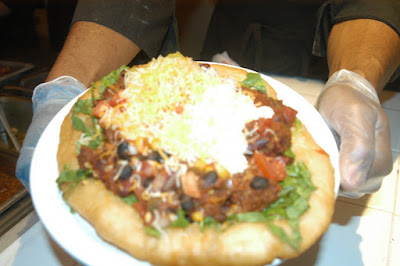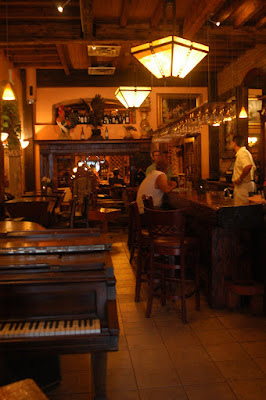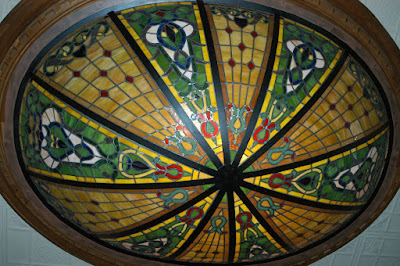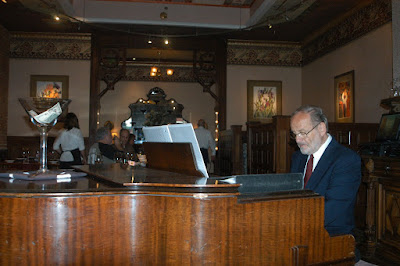As most of you know, when we embarked on this adventure, we had ONE goal -- to experience the Crazy Horse Memorial in Custer, SD. Actually, we visited the memorial three times -- once for the better part of one day and twice for the night laser light shows (and mountain blast one of those nights). Additionally, we remained in the area long enough to visit Pine Ridge, Wounded Knee, the Badlands, the Black Hills, and Mount Rushmore -- savoring every minute. One day I hope to return for a longer visit -- and to see the progress on Crazy Horse.
Over the past few days we have wandered with some direction (but no reservations) through South Dakota, Montana, Wyoming, Utah, Colorado, New Mexico, and now Texas -- tomorrow we will reach Oklahoma City. In all, we have been in 12 states since we started in Missouri and traveled up through Kansas, Iowa, and Nebraska before reaching South Dakota. Along the way when we came to consensus about our next destination, I would plug in the town/city into my GPS (we have affectionately named "Olive"). If we veered from our intended route, "Olive" would speak out saying "recalculating, recalculating." She did a lot of "recalculating" as we changed our collective minds on a whim. Initially, we had ambitiously included the Grand Canyon, Sedona (AZ), Santa Fe, and Taos as potential stops BUT we "recalculated" in Grand Junction and decided to postpone those locations and head towards Durango and Mesa Verde instead..."recalculating" as we went. In school we must "monitor and adjust" -- recalculating constantly -- and that is a good thing.

This is the scene from our lodgings in Durango...mountains all around.
Today as we drove down from Durango through numerous reservations of the Navajos and the Apaches -- through expansive range lands without seeing a person or animal -- along highways with NO billboards -- under a huge sky, it was difficult to not feel pride in this country's beauty...which comes in many forms. From a mountain pass with snow-topped caps to red-rocked mesas to rolling hills to desert-like plains, I never cease to be amazed and awed. We have managed to be on few Interstates preferring the scenic byways.
For whatever reasons, we do not hear about the many areas involved in various types of energy production in this country...but my favorite has to be the lines of stately white wind turbines that suddenly appear on a horizon or on top of a mesa. I don't know why we don't have these in the SC yet. These turbines are HUGE but almost balletic in their movements. Very graceful. Elegant. This afternoon as we entered Texas, there was yet another field lined with these turbines and a rainbow falling right in the middle of them. Almost surreal. Couldn't find a pull-over soon enough to catch that on film.
Thanks to all of you who followed our travels. Sorry for the blog snafus along the way. I have never been able to figure out how to make the picture on the top right-hand side of the page stay with the appropriate day. Instead, it becomes permanent attaching to previous days. Oh, well...I'm still learning (and remember that this is my first attempt at blogging). And we never found that convertible to stage our "Thelma and Louise" photo shoot. Perhaps another trip. :-) Additionally, I have been gone from home almost three weeks -- I have so many things to do before school begins in a month. Where does the time go?
Reflections/Observations along the way:1. I now have a greater understanding for the lyrics of "Home, Home on the Range." One part of the lyrics is "...and the skies are not cloudy all day." We drove through ranges after ranges seeing buffalo (not sure they were playing) and skies with NO CLOUDS. Think the part about "...where seldom is heard a discouraging word..." relates to the fact that there are FEW humans around from whom to hear such.
2. If driving the Beartooth Highway again, it would only be from Red Lodge, MT to Cooke City -- not the opposite direction.
3. If lodging in Yellowstone Park is a goal, phone ahead.
4. While driving through Yellowstone and you suddenly see a cluster of cars pulled off the road, you can be sure it relates to a wildlife event. Bring your camera AND your tripod for such photo opportunities. It is amazing how quickly folks could whip out those tripods!
5. Don't expect to see many cars or trucks along I-90...or gas stations or places to eat or anything except ranges.
6. We often wondered where everyone was as we traveled the scenic back roads and byways. I know. They were all at Yellowstone waiting for another Old Faithful show. You would not have believed how many cars and people appeared at this one site -- more of a concentration than we saw on the entire trip.
7. Jackson (the city) and Jackson Hole (the area) are definitely on my list to do again...for a longer time. Also, little towns in Montana and Wyoming, the hot springs in a number of places, and fly fishing in some of the many streams we passed.
8. The drive between the south entrance to Yellowstone and Jackson Hole is not to be missed. The snow-capped Tetons rise high and majestic.
9. Leaving the main roads can give pause for thought. We were fortunate that we had no mishaps traveling south through Montana, Wyoming, Colorado, Utah, and New Mexico.
10. There are still some very nice people out there. The two mechanics in Vernal, Utah who worked diligently to repair an over-heating problem on a 10-year old car (in a place that they said was a "truck town") were kind, helpful, gracious, and HONEST. They could have left us waiting for a part to arrive MAYBE in three days; instead, they jerry-rigged the problem to be handled at a later date. We never had another problem.
11. The scenic highways have few to NO billboards. How refreshing.
12. You can get great meals in some small towns...surprisingly good fare.
13. There are cars that get 30+ mpg -- I haven't had one in years -- and it is nice to not have to fill up so often.
14. I had forgotten the ferocity of the winds in west Texas. Years ago we traveled through this area and noticed the tumbleweed not tumbling but flying across the roads. Signs in front of businesses were on springs because the winds were so strong...otherwise, the signs would be bent or blown over. Today when we stopped for gas in west Texas, we almost had to hold onto the car to pump gas. Got my attention!
15. Our history books do an unacceptable job of portraying the plight of the Native Americans and the holocaust they have endured. There is much we could learn from their ways. There is much which this country owes them today.
16. Life is TOO short. There is so much to see and do. Don't wait.
17. This land is magnificent and grand -- and the sweeping vistas define descriptions. As I have previously stated, I'm all out of superlative adjectives. :-)
18. I loved our up-close-and-personal moments with the buffalo on the roadsides -- and all the other wildlife we encountered.
19. I marvel at the people who built the highways up and through some treacherous heights. And, I cannot fathom driving these roads on a regular basis.
20. While all Best Westerns are not created equal, they have exceptional complimentary breakfasts.
21. The back side of George Washington's head coming through the trees looks surreal when viewed from the road approaching the monument.
22. I had forgotten the 50+ shades of adobe used on structures around the Santa Fe area...even on the overpasses on the highway.
23. I-40 has entirely TOO many trucks on it.
24. The little town of Tucumcari on historic Route 66 is almost a ghost town. Someone needs to turn off the lights and forward the mail. Wonder how many other small towns along the route have succumbed in similar fashions?
25. Route 66 parallels I-40 for a long way. It looks so small and narrow but has transported millions over the years. What a storied past.
26. Fry bread should be eaten warm, not warmed up.
27. AAA has great TripTiks -- be sure they give you the old style -- better info and maps. Additionally, many motels offer 10-20% discounts on room rates with AAA membership.
28. A GPS is a good thing. It kept us straight and re-enforced turns and directions. Also, somehow or other, this little device can tell how fast you are going, what the speed limit is, where the nearest gas station is located, ATMs, lodging, etc. It is a handy-dandy gadget. We would never have found Bette's Kitchen on the Pine Ridge Reservation without it! There were NO signs advertising this place. The sign for Black Elk Road is almost obscured by bushes. If it weren't for the small picture on the flier AND the GPS, we would never have found it. Bette's niece said she misses the turnoff on occasion.
29. Before leaving on a trip, ask friends what they know or recommend about your destination. My neighbors provided a wealth of info for this trip and great suggestions -- and even maps.
30. We are fortunate and thankful to have had safe travelling mercies.
After a brief visit in OKC, I'll be flying home with many wonderful memories. I haven't been in Oklahoma since we left in the late 50s. We lived in Muskogee while Daddy was responsible for building a high energy fuel plant for rockets that would go into space. Think about
Rocket Boys and
October Sky and the race for space. It was a hush-hush project and we were the only Navy family in town. Never having been to Oklahoma City, I'm looking forward to seeing it.
Some day I hope you find a traveling companion and hit the roads without reservations. Never a dull moment...an adventure (and perhaps a surprise) around many curves in the road.
Safe travels to all!
 She is holding one of her fancier dress pieces -- unfortunately, the display piece comes across too light in the picture...but the point of the picture is the wonderful spirit of White Antelope. She and her son suffered serious damages in the 1995 Murrah Building blast losing everything -- it has taken them years to rebuild their lives, home, and business.
She is holding one of her fancier dress pieces -- unfortunately, the display piece comes across too light in the picture...but the point of the picture is the wonderful spirit of White Antelope. She and her son suffered serious damages in the 1995 Murrah Building blast losing everything -- it has taken them years to rebuild their lives, home, and business.  As you can see by this wall, people are still leaving memorials on peripheral fencing in the former Murrah Building area. The memorial park to the victims features a large granite structure with 9:03 etched above the arch -- the time the bomb exploded. You can see a few of the chairs through the trees that honor each of the victims.
As you can see by this wall, people are still leaving memorials on peripheral fencing in the former Murrah Building area. The memorial park to the victims features a large granite structure with 9:03 etched above the arch -- the time the bomb exploded. You can see a few of the chairs through the trees that honor each of the victims. 

 This museum requires a much longer visit.
This museum requires a much longer visit.
 They are researching many points along the route -- and this Red Barn, an architectural feat, is one of them. While we were upstairs, "Butch" wanted to show me how that area served as a dance floor. So, he and I two-stepped around the room with NO music while the two Dane dudes filmed. Can't imagine how this piece of Americana will play back home. :-)
They are researching many points along the route -- and this Red Barn, an architectural feat, is one of them. While we were upstairs, "Butch" wanted to show me how that area served as a dance floor. So, he and I two-stepped around the room with NO music while the two Dane dudes filmed. Can't imagine how this piece of Americana will play back home. :-) 












































